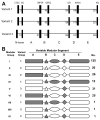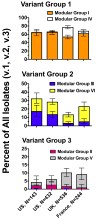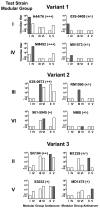Frequency of factor H-binding protein modular groups and susceptibility to cross-reactive bactericidal activity in invasive meningococcal isolates
- PMID: 20044056
- PMCID: PMC2830318
- DOI: 10.1016/j.vaccine.2009.12.027
Frequency of factor H-binding protein modular groups and susceptibility to cross-reactive bactericidal activity in invasive meningococcal isolates
Abstract
Meningococcal factor H-binding protein (fHbp) is a promising vaccine candidate that elicits serum bactericidal antibodies in humans. Based on sequence variability of the entire protein, fHbp has been divided into three variant groups or two sub-families. We recently reported that the fHbp architecture was modular, consisting of five variable segments, each encoded by genes from one of two lineages. Based on combinations of segments from different lineages, all 70 known fHbp sequence variants could be classified into one of six modular groups. In this study, we analyzed sequences of 172 new fHbp variants that were available from public databases. All but three variants could be classified into one of the six previously described modular groups. Among systematically collected invasive group B isolates from the U.S. and Europe, modular group I overall was most common (60%) but group IV (natural chimeras) accounted for 23% of UK isolates and <1% of U.S. isolates (P<0.0001). Mouse antisera to recombinant fHbp from each of the modular groups showed modular group-specific bactericidal activity against strains with low fHbp expression but had broader activity against strains with higher fHbp expression. Thus both modular group and relative expression of fHbp affected strain susceptibility to anti-fHbp bactericidal activity. The results confirmed the modular architecture of fHbp and underscored its importance for the design of broadly protective group B vaccines in different regions.
Copyright 2009 Elsevier Ltd. All rights reserved.
Figures






Similar articles
-
A Meningococcal Outer Membrane Vesicle Vaccine with Overexpressed Mutant FHbp Elicits Higher Protective Antibody Responses in Infant Rhesus Macaques than a Licensed Serogroup B Vaccine.mBio. 2019 Jun 18;10(3):e01231-19. doi: 10.1128/mBio.01231-19. mBio. 2019. PMID: 31213564 Free PMC article.
-
Meningococcal factor H binding proteins in epidemic strains from Africa: implications for vaccine development.PLoS Negl Trop Dis. 2011 Sep;5(9):e1302. doi: 10.1371/journal.pntd.0001302. Epub 2011 Sep 6. PLoS Negl Trop Dis. 2011. PMID: 21909444 Free PMC article.
-
Contribution of factor H-Binding protein sequence to the cross-reactivity of meningococcal native outer membrane vesicle vaccines with over-expressed fHbp variant group 1.PLoS One. 2017 Jul 25;12(7):e0181508. doi: 10.1371/journal.pone.0181508. eCollection 2017. PLoS One. 2017. PMID: 28742866 Free PMC article.
-
Does binding of complement factor H to the meningococcal vaccine antigen, factor H binding protein, decrease protective serum antibody responses?Clin Vaccine Immunol. 2013 Aug;20(8):1099-107. doi: 10.1128/CVI.00260-13. Epub 2013 Jun 5. Clin Vaccine Immunol. 2013. PMID: 23740919 Free PMC article. Review.
-
Broad vaccine protection against Neisseria meningitidis using factor H binding protein.Vaccine. 2020 Nov 17;38(49):7716-7727. doi: 10.1016/j.vaccine.2020.08.031. Epub 2020 Aug 30. Vaccine. 2020. PMID: 32878710 Free PMC article. Review.
Cited by
-
Cooperative serum bactericidal activity between human antibodies to meningococcal factor H binding protein and neisserial heparin binding antigen.Vaccine. 2011 Feb 24;29(10):1968-73. doi: 10.1016/j.vaccine.2010.12.075. Epub 2011 Jan 15. Vaccine. 2011. PMID: 21241734 Free PMC article.
-
Design of meningococcal factor H binding protein mutant vaccines that do not bind human complement factor H.Infect Immun. 2012 Aug;80(8):2667-77. doi: 10.1128/IAI.00103-12. Epub 2012 May 21. Infect Immun. 2012. PMID: 22615247 Free PMC article.
-
Potential impact of the bivalent rLP2806 vaccine on Neisseria meningitidis carriage and invasive serogroup B disease.Hum Vaccin Immunother. 2013 Mar;9(3):471-9. doi: 10.4161/hv.23222. Epub 2012 Dec 18. Hum Vaccin Immunother. 2013. PMID: 23249817 Free PMC article.
-
Effect of factor H-binding protein sequence variation on factor H binding and survival of Neisseria meningitidis in human blood.Infect Immun. 2011 Jan;79(1):353-9. doi: 10.1128/IAI.00849-10. Epub 2010 Nov 1. Infect Immun. 2011. PMID: 21041484 Free PMC article.
-
Combined roles of human IgG subclass, alternative complement pathway activation, and epitope density in the bactericidal activity of antibodies to meningococcal factor h binding protein.Infect Immun. 2012 Jan;80(1):187-94. doi: 10.1128/IAI.05956-11. Epub 2011 Nov 7. Infect Immun. 2012. PMID: 22064712 Free PMC article.
References
-
- Tettelin H, Saunders NJ, Heidelberg J, Jeffries AC, Nelson KE, Eisen JA, et al. Complete genome sequence of Neisseria meningitidis serogroup B strain MC58. Science. 2000;287(5459):1809–15. - PubMed
-
- Grifantini R, Bartolini E, Muzzi A, Draghi M, Frigimelica E, Berger J, et al. Previously unrecognized vaccine candidates against group B meningococcus identified by DNA microarrays. Nat Biotechnol. 2002;20(9):914–21. - PubMed
-
- Hotopp JC, Grifantini R, Kumar N, Tzeng YL, Fouts D, Frigimelica E, et al. Comparative genomics of Neisseria meningitidis: core genome, islands of horizontal transfer and pathogen-specific genes. Microbiology. 2006;152(Pt 12):3733–49. - PubMed
-
- Pizza M, Scarlato V, Masignani V, Giuliani MM, Arico B, Comanducci M, et al. Identification of vaccine candidates against serogroup B meningococcus by whole-genome sequencing. Science. 2000;287(5459):1816–20. - PubMed
-
- Bernardini G, Braconi D, Lusini P, Santucci A. Postgenomics of Neisseria meningitidis: an update. Expert Rev Proteomics. 2009;6(2):135–43. - PubMed
Publication types
MeSH terms
Substances
Grants and funding
LinkOut - more resources
Full Text Sources
Other Literature Sources

